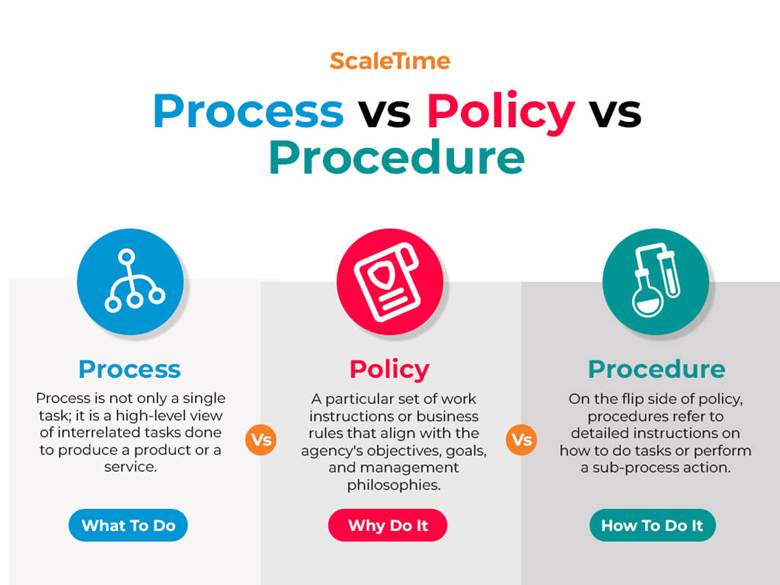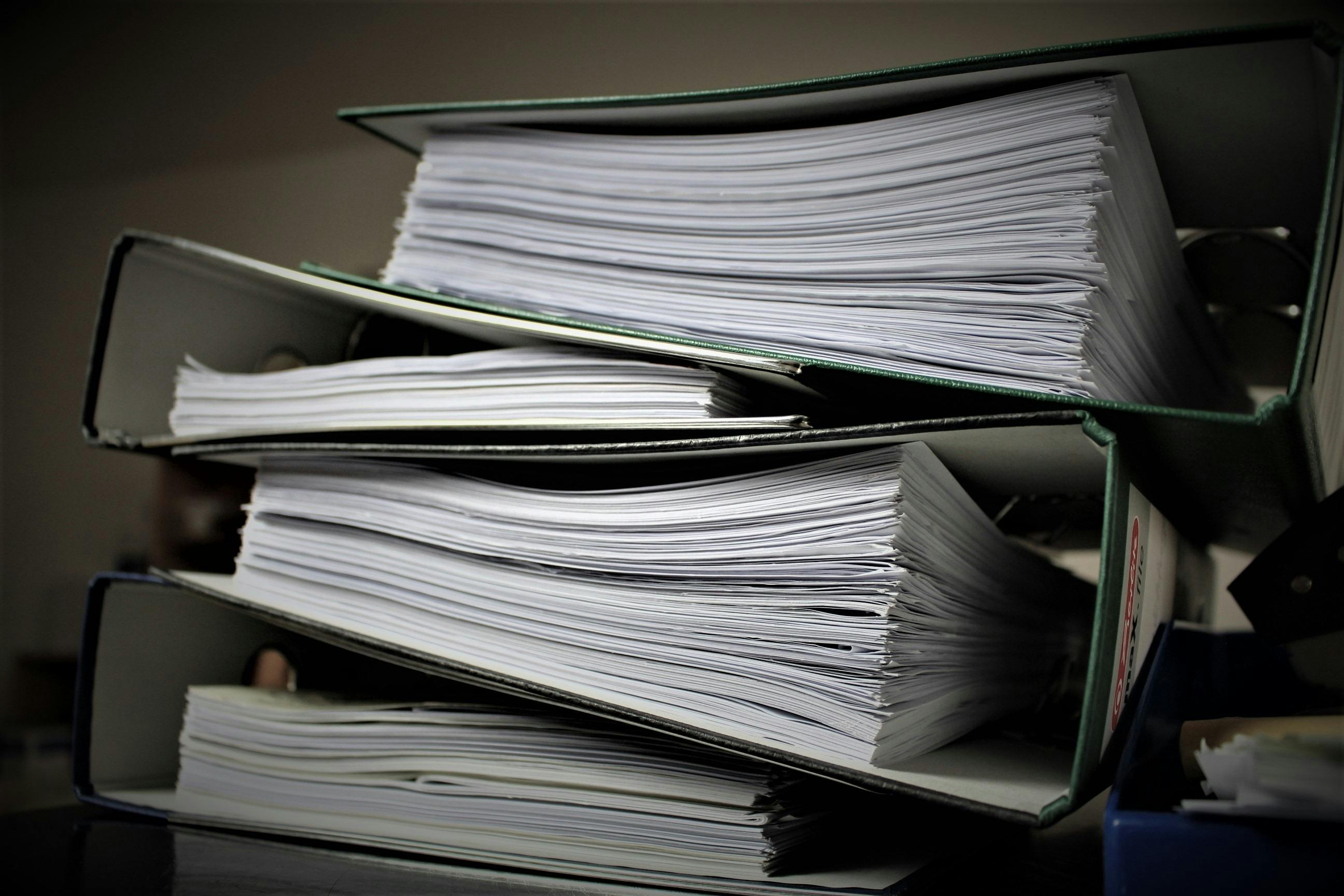
We've all had that one time we are confused as to why our employees have failed to understand the instructions, we gave them.
Yes, I have given them clear steps.
Yes, I have demonstrated how to do it.
Why are they finding it hard to comply?
Your team may be unable to keep up because they are finding it hard to tell the difference between the rules to follow and the actions, they need to take to perform a task well.
Although these are both important for your agency to successfully deliver the desired outcome, it is still necessary to differentiate three elements essential to your business: policy, process, and procedure.

Organizations often mistake these three terms as being one and the same, but in reality, they are different tools with different definitions, applications, and documentation.
In this article, we will explore each element’s difference with the other, how they work together, and what factors are essential when researching and developing documentation for your organization. By the end of this article, you’ll be more confident in applying them to your agency.
PLUS we provide a bonus tip on how we can help you get started.
Let’s begin!
What is a Process?

A process is a broad outline of what can be done so that policies or business objectives can be achieved. It shows the main steps needed to go from point A to point B: the grand map to carry out interrelated tasks.
A business process is not only a single task; it is a high-level view of interrelated tasks done to produce a product or a service. It gives a big picture of the duties and assignments with the departments doing them. It serves as a connector to assignments done within an agency arm or even across several divisions across an agency.
Here are some process qualities: processes define “what to do” to complete a service or create a product in an organization. Usually, processes cross departments. Diagrams are sometimes created through process maps, which describe the points when and where a person in authority performs or approves the task. Process diagrams are workflow charts that are graphical representations of the entire process flow. Processes also have a process map that bridges point A to point B and the people who control the action.
If the agency implements a process of delivering a product out of a business concept, it shows you that point A is the business concept while point B is the end product or service. Sometimes, the total process crosses department lines; however, they will always contain specific instructions on following the company's strategic direction to get to the desired destination.
The total process converts input to output, covering each process step underneath it so that an employee knows what to expect from start to finish after a function has been activated. That way, verifying if the task has started or been completed already gets easier!
What Is A Policy?

A policy is a high-level guideline or principle that sets the agency’s business direction. Policies are a set of rules and objectives that keep an agency’s decision-making on track.
Most companies have a particular set of work instructions. They are defined as policies. These policies are business rules that align with the agency's objectives, goals, and management philosophies.
A policy creation demonstrates an organization's best practice; without policies, the other two elements – the processes and procedures – will be affected. They also help create control points with which you can monitor the extent to which policies and procedures are being adhered to.
Business policies can be regarded as laws inside the agency because they build the framework from which an organization helps its team quickly learn about the company. Tasks, especially repetitive ones, be implemented in a more standardized manner. Unnecessary errors can be avoided because there is already a policy put down, and people who positively response to it ensure that the company operates smoothly.
A distinct quality of a policy is that it will always let a company understand its destination clearly. However, it will not specify the direction to take or how to get there.
Policies address related subject matter
An excellent example of a policy would be a data privacy policy. This policy is often included in an agency's rulebook. This safety protocol assures its clients that their records and transactions are kept private. It is also a a part of Information Management Policy to protect your team members, ensuring that along with customer information, the employees' information security is also maintained and safely kept.
What Is A Procedure?
Now that we have defined process and policy, let’s proceed with defining a procedure. A business procedure is a clear, step-by-step list of actions that help us get something done. It’s like a recipe guide that explains a detailed way to follow and do tasks correctly, consistently, and safely, every time.
A procedure shows company instructions for regular duties, including how to onboard a new hire, process payments, and handle the customer onboarding process, which makes things less chaotic and doesn't affect our standard operating procedures when our daily work gets busy. It also saves the management from all the guesswork, missing steps, and unnecessary costs, so work is smoother and more efficient.
What Is the Difference Between Procedure and Policy?

On the other hand, procedures refer to detailed instructions on how to do tasks or perform a sub-process action. Procedures should be aligned with all business rules contained in the company's policy.
Special procedure manuals give specific instructions and reports on how to go from point A to point B, how employees will go to the next phase, or how they will know if the process is complete.
Procedure qualities: procedures define the steps
Procedures identify which instructions are needed to support team members in carrying out specific work. It is also a way to empower them to take control over work instruction. Business procedures are like checklists that help you manage tasks more efficiently by delegating assignments to make the most of your time as your management learns to follow and document industry specifics.
A more detailed procedure can even be established by creating a desk top procedure for easy accessibility to the different department lines. This documentation presents procedure components, the detailed procedure, and business rules.
Developing documentation requires understanding the process tasks, how to properly structure the document, and any other related subject matter. The content contained in the procedures document should identify policy and graphically display system instructions.
How does a policy differ from a procedure?
The key difference between policies and procedures is that procedures are steps to achieve a particular outcome, which can be as little as a single task or as big as a full-blown company process. In contrast, policies address the reason behind constructing each procedure.
The policy is the “why”– the foundation and rationality – while the procedure is the “how”, the agency's compliance to the why, and the manner or method by which you systematically achieve the goal.
There is no specific procedure for each policy, but each of your procedures should align with the management's business policy to keep it in check and operational.
What About A Business Process vs. Procedure?

Business processes are useful information for customers and employees to learn the workflow outline and identify the responsible decision-making body. The procedure then elaborates on the series of steps required by the details of activity within the process.
The employee promotion process, for example, is composed of several points to rising from a certain rank to another. It involves several people who perform a specific service (role or responsibility) – the employee, the immediate supervisor, and the senior management. It can include a few sub-processes like evaluation, training, submission of requirements, and employee and colleague interviews, to name a few.
The procedure under each step discusses each detail from filling out the application form, giving X number of hours to perform promotion-related tasks, attending which seminars, and waiting X number of days for the approving body to decide.
Key Differences Between Processes, Policies, and Procedures
Before deciding which one to create or use, let’s take a look at what sets a policy, process, and procedure apart from each other.
Purpose
Each one has a different job to do, and when it comes to policy, it lays down the rule that keeps things in line with our agency’s values, goals, and even the law. A process, on the other hand, shows us the big picture. It maps out the flow of work so people will know who’s doing what and in what order. Then there’s the procedure, which explains the practical how-tos to keep the ball rolling every step of the way.
Focus
Imagine you’re on a mountain with a high-altitude view: that’s what policies are all about. It gives us the perspective so we’ll know what strategy to make and what tone to set. Processes are the ones in the middle, laying out the things that perform and function to bridge the gap between the policies and procedures. And what about the procedures? These are the ones right on the ground with the team to show the exact steps for doing the work.
Who Uses Them
A policy is your best friend if you’re setting the agency’s direction, while a process is for project managers and team leads who need something to keep the engine well-oiled and running smoothly. For our team members looking for a cheat sheet, procedures are their savior - a collection of instruction manuals to follow, always ready to save the day.
When to Use Processes, Policies, and Procedures?
After differentiating what each one is, you may wonder: when do we actually use them?
● Use a policy to create rules for everyone to follow, with no exceptions. Policies help our people understand what is expected of them and where everyone stands about a particular belief or principle.
● Use a process to manage work that involves interrelated actions. Processes are a great game plan for multiple tasks and people to prevent bottlenecks and micromanaging.
● Use a procedure to save time and promote efficiency. Procedures make a very specific task turn into consistency magic. The best part? You might never hear “hey, how do you do this again” ever again.
Case Studies and Real-World Examples

The best way to see how these the elements work together is to apply them in real life. Let’s say you’re planning a team lunch:
POLICY:
You’ve got a company-wide agreement that says, “All departments cover lunch every last Friday of the month within a set budget.” It’s a rule that sets the frequency, the people involved, the budget, and the time.
Agency application: These are the laws that govern your business. It helps us comply with ethical and industry standards like HR Policy on filing absences, Data and Privacy policy when gathering client information, and fair resolution of complaints under Customer Policy.
PROCESS:
It maps out the overall flow of what will take place during the team lunch:
- Check the set budget
- Gather the team’s food preferences
- Choose a restaurant
- Place the order
- Handle payment and delivery
- Share the invoice with finance
Agency application: An agency’s business process for a customer onboarding process may look like this:
- Send the welcome mail
- Schedule the kickoff call
- Set up the project and communication tools
- Share timelines and team responsibilities
- Gather initial documentation
PROCEDURE:
So, for Step#4: Place the order, a procedure for that will be:
- Open the food app
- Select the chosen restaurant
- Enter team preferences and dietary notes
- Enter the delivery address and time
- Select the budget code from the payment options and place the order
Agency application: For example, we zoom in on Step#1: Send the welcome email during the onboarding process:
- Log in to the CRM
- Choose the Welcome Email template from the Onboarding Client folder
- Personalize with the client’s name and project details
- Double-check all the information
- Send within 24 hours of contract signing
See how they are all in sync? Whether it’s a top-level business policy on Anti-Harassment or something we do every day, like confirming an invoice, having clear policies, processes, and procedures means no one’s stuck scrolling through old mails from an ex-employee to figure out what happened. It keeps your agency on the same page on what element to use for every situation.
What Are the Benefits of Knowing the Definition of Each Element?
We have now defined each key element together with its qualities and purpose. By verifying the differences and similarities of each, an agency can create its own structure of policies, processes, and procedures to improve its productivity and efficiency.
It is also useful information that can guide point persons in handling resources and can be vital to enhancing employee and client systems. It plays an important role in training new employees and tenured employees to observe compliance.
Organizations can also build on their internal and external connections by polishing up their policies, processes, and procedures. Marketing strategies can be easily executed by properly explaining guidelines to boost customer relationships. Departments implement these elements with reporting and proper documentation for future data baseline and evaluation.
Giving and receiving input on completed guidelines can serve as review and feedback for employees' performance and foster communication in finding areas for improvement in your agency.

Frequently Asked Questions (FAQs)
● What’s the difference between a workflow and a process?
A process is a general series of steps needed to reach an outcome or objective. On the other hand, a workflow is more detailed because it shows the relationship of each task, the members involved, the tools, and the timeline for completing the steps of that process.
● Can a policy include procedures?
A policy does not exactly include the procedures since it’s a set of rules and not step-by-step instructions. However, it can point out processes and procedures related to that particular policy to show how it can be followed and achieved.
● How do you document processes effectively?
To document processes effectively, it should be clear and simple. Keep information comprehensive and updated so it matches the production of products or services. Make sure the steps are easy to follow, and make sure you create a process documentation template to make it customizable and scalable.
● What tools can help manage processes, policies, and procedures?
There are plenty of great tools to keep everything organized and up-to-date. Tools like Asana, Notion, Click-Up, and Google Workspace allow businesses to create, share, communicate, and track changes. Choose the best tool according to your team size, style, and budget.
Key Takeaway
Business policies, processes, and procedures are more than just paperwork: they help agency leaders work smart, build consistency, and improve efficiency.
Here’s a quick recap of what we discussed:
● Policies are rules that point an agency’s direction, built on its values, principles, and objectives
● Processes lay out the general flow of what needs to be done, like a map to go from point A to point B
● Procedures are the step-by-step guidelines on how to perform a process
● Assessing and revisiting these elements regularly keeps the team aligned, the clients happy, and the mistakes down to zero
With ScaleTime, you don’t have to figure it all out alone. We’ll help you fix (or build) your policies, processes, and procedures to give you the right structure that helps your agency run like clockwork, so your business is ready for growth.
Take our FREE agency growth assessment quiz to see where things are falling short. We’ll send you a bundle of resources tailored to scale your agency.





















%20(1).gif)





